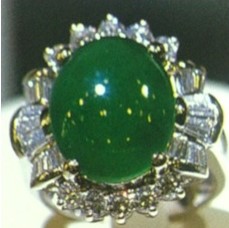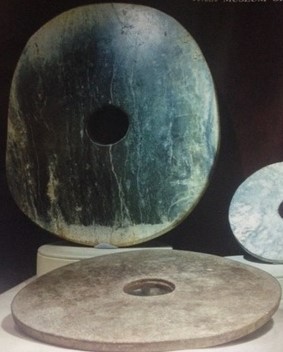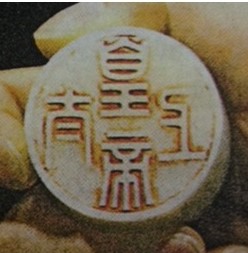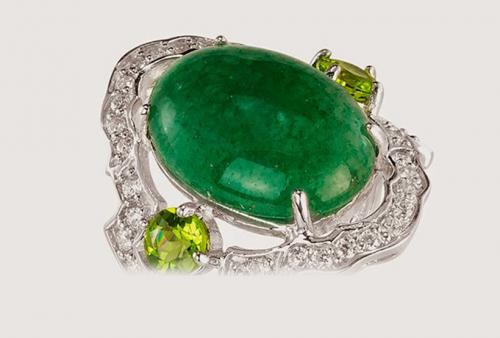Daonapa Naowarangsee*
Jade is a gemstone embedded with legends and beliefs deep-rooted in the lives of Chinese people. In Chinese culture, it is popularly used in ceremonies, made into jewelry, artifacts, charms, artistic figures, as well as objects of worship. All aforementioned uses are all related to the belief and the faith adhered to this particular type of gemstone. Moreover, apart from Chinese culture, jade has always had a worldwide influence. Jade have also been used for jewelry-making as well as for decorating royal insignia in other countries all over the world.
Meaning and Origin
Jade is a kind of stone with unique characteristics. It has greater hardness than other ordinary types of stones, and is exceptionally beautiful. Its name derives from a Spanish name "Piedra de hijada”which means the stone of the side. It was believed to have the power to cure kidney disease and heartburn. In Burmese, jade is called ‘Chao Seng’ which means green stone.
In Mandarin Chinese, jade is called Yu which has the meaning of the beauty and perfection as understood in Chinese culture. It is regarded the most precious gemstone. Moreover, in Chinese ancient literature from around five thousand years ago, there was a philosophical piece that compares characteristics of jade with human heart.
Types of Jade
According to its chemical composition, there are two types of jade:
1. Jadeite or Burmese jade
Jadeite is of the best quality in the world. Its source is located in Kachin state, Myanmar. Jadeite is a kind of metamorphic rocks with the mineral composition of Aluminum and Sodium. Under pressure, it forms a specific kind of rock with variations in colours and degrees of translucence. Colour variations depend on trace element of metal within the composition. If there is none, jadeite will be white and clear. Significant elements that affect colours variation in jadeite are:
Chromium – white colour
Iron – yellow, brownish to orange colour
Manganese – pick, and lavender colour
Jadeite is considered a stone with a high hardness. It has a Mohs hardness of about 7.0 to 8.5. Jadeite has a dense and granular composition which makes it harder than rocks, and more resistant to breaking than other kinds of clear gemstone. Therefore, jadeite is usually chosen to in the making of jewelry of high value, for example, as the gem of the ring, a pendant, or a bracelet.

Imperial Jade
Jadeite with the highest quality, which is also the most expensive, is Imperial Jade. It is semi-transparent and has medium to dark shade of evenly green colour. This kind is considered the best in the world. It can found in Myanmar, but quite rare. It has been regarded as a regal gem; hence the name, ‘Imperial Jade’.
2. Nephrite or Chinese jade
It is one of the first types of jade that became known to the world due to its abundance and its thousands-year-long history in Chinese culture. Chinese people havethe longest and the most intimate relationshipwith this type of jade than other peoples in the world. Important sources of nephrite are the territory 100 kilometres off the east of Alaska’s Border in British Columbia, Canada, Taiwan, New Zealand, Australia, China, United States, and Russia. Its mineral composition includes calcium, magnesium, and iron, resulting in the rarity of nephrite jade with a clear green colour. Nephrite jade has no great variation in colour; they mostly possess mainly dark blackish greens, grays, browns, and white. Black spots are usually found in the texture as a result of iron oxide. It has a Mohs hardness of about 5 to 6 which is considerably lower than jadeite jade. Therefore, nephrite jade is called by another name as ‘soft jade’.
Although nephrite jade is inferior to jadeite jade in quality and colour variations, it is unique in its toughness due to its interlocking meshwork of fine fibres which are in needle-like shape of crystal in itself. This quality makes nephrite suitable for carving. Therefore, it is a common material for figures in different shapes and sizes, for examples, figures of Buddha or Chinese gods, seals, different kinds of utensils such as tableware, vase, or ornaments such as bangles or rings.
The Uses of Jade
Apart from its beauty and endurance, jade as a type of ornament is also regarded as a symbol of status. Moreover, it is fashioned into everyday objects, such as plates, bowls, drinking glasses, lamps, table, weapons. It is also carved into objects of worship and other kinds of symbols. These uses of jade first became common in Shang(1600-1046BCE) and Zhou(1046-256BCE) Dynasty. During these periods, jade was made into tools such as weapons, seals for civil servants, ornaments. It was also used to make large-sized sculptures for the purpose of decoration in homes.
During Han Dynasty (206BCE-220AD), jade began to be used as material for tableware or containers resembling Chinaware. It was used to make carved figures of human and animals in Yuan (1279-1368AD) and Ming Dynasty (1368-1644AD). In Qing Dynasty (1644-1912AD), carving jade into objects in nature became popular. In this period, jade objects were made in shapes of flowers, fruits, and animals.
Uses of jade can be categorised according to function as follows:
1. Ornaments Jade ornaments has always been popular. Examples include jade bangles, rings, necklace, pendants, earrings, and brooch.
2. Utensils Including plates, bowls, drinking glasses, weapons.
3. Objects of worship, and seals For example, Buddha statues, Chinese gods figurines, and items in shapes of animals or Chinese symbols that are considered auspicious. These items are made for the purpose of personal carry and worship.
Jade: Faith and Beliefs
Jade is naturally formed. It is believed in Chinese culture that this process take over millions years. Therefore, it is also believed that jade absorbs the energy of the cosmos, including the heat from the sun, the coolness from the moon, as well as the energy from other stars. According to Chinese beliefs, jade is the source in which the energy of life is concentrated. It is believed that jade is a medium between earth and the cosmos, and that it is essential to ascending to heaven. Therefore, Chinese people usually have their name plaque made of jade for the purpose of guiding them to heaven after their death. Jade is also used to make family name plaques to symbolise the continuation of the family.
Moreover, jade is popular material for making ornaments and portable items due to the belief that it can protect and attract good things into the wearer’s life. Apart from aesthetic and auspicious reason, jade ornaments are used to predict health conditions or future events. For example, if a jade item that is being worn is clear and bright in colour, it means the wearer is in great luck. On the contrary, if the item seems somber, it means an arrival of a bad fortune for the wearer.

Nephrite Jade
(Shang Dynasty)
At Chinese court, jade was believed to be a royal symbol to be bestowed to civil servants who rendered good service to the emperor. One of the items the emperor gave noblemen as a gift of honour was bi—a round flat disc with a hole in the middle which symbolizes heaven. Additionally, at the hands of high skilled craftsmen, jade was crafted into royal insignias, rings, wands, or the throne to signify the royal power. Due to the belief that jade is a stone of heaven, it was regarded as an appropriate material for the items used by the emperor or the Son of Heaven, both in life and in death. The Chinese court believed that jade had the power to prevent decomposition, thus immortal the body. An evidence of this belief was found in grave sites from Han dynasty. In the tomb of Prince Liu Sheng and The Royal Consort Dou Won, the bodies were found to be wearing a gown made with thin jade plates sewed with golden threads. This practice is for the purpose of preserving the bodies. Jade bi were found scattered around the bodies in the caskets due to the belief that they were to guide the royal souls to heaven. It was also believed that drinking jade powder mixed with water could strengthen muscles and bones, boosting physical power as well as courage.
Apart from Chinese people, jade was found to have been popular also among the Aztec people in Latin America. They believe that if jade is worn on the waist area, it will help cure stomach pain and soreness at the waist. Among the Maori people in New Zealand, it is believed that jade is a symbol of the inheritance of authority within a family. According to a tradition in ancient Egypt, jade was placed in the mouth of the deceased, who were of noble birth, to replace the heart.
Normally jade is carved into various shapes and forms which are deemed auspicious to the owner. However, colours of jade are also signification of various beliefs, customs, and meanings:

The royal seal of the emperor
(Nephrite Jade)
- Green Extremely popular due to the belief that it is a source of incoming wealth.
- White Brings luck to and ensures a long life of the owner.
- Purple Creates richness and happiness. Heals owner’s moods.
- Red Connects with the emotion of love. Calms anger and relieves stress.
- Yellow Reinvigorates life. Empowers the owner.
Unlike other gemstone, the beliefs about jade in different cultures are unique in that they are all related to auspiciousness, goodness, powerfulness.
Jade and Thai National Treasures
Although jade’s popularity in Thailand is not as great as in China, jade has also been selected as a material for Buddha image or other kinds of objects of worship. The Emerald Buddha, which is regarded highly by Thai people as the nation’s treasure, is made with nephrite jade. The court of King Chulachomklao or King Rama V, whose reign was an important period in building relations with the West, was presented with a number of jade ornaments and utensils made by the royal craftsmen of the Western courts. One example is a pill box made with nephrite jade which were presented to King Rama V by The House of Fabergé.
Jade was believed to be the priceless stone of heaven, thus appropriate to accompany the emperor who is regarded as the son of heaven. This can be seen through royal utensils and accessories which were made of jade and presented to the Chinese emperors. It shows the importance of jade in Chinese culture that dates back several hundred years, and has great influence on various cultures all over the world.
* Curator, Professtional Level at Bureau of Grand National Treasure, the Treasury Department



